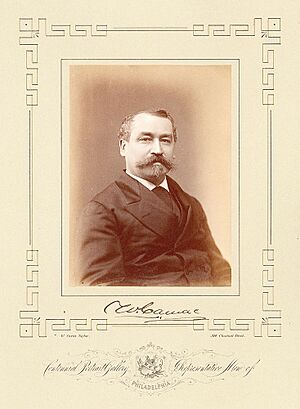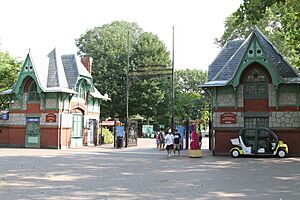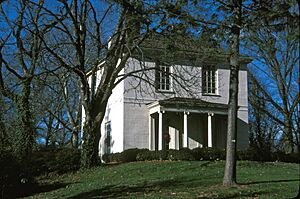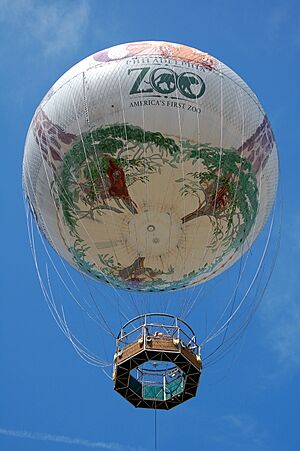Philadelphia Zoo facts for kids
 |
|
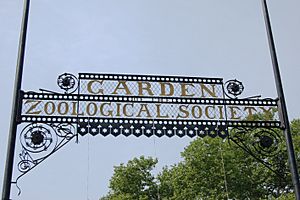
The gate above the zoo's entrance
|
|
| Date opened | July 1, 1874 |
|---|---|
| Location | Philadelphia, Pennsylvania, U.S. |
| Land area | 42 acres (17 ha) |
| Coordinates | 39°58′21″N 75°11′48″W / 39.97250°N 75.19667°W |
| No. of animals | ~1,700 |
| No. of species | 340+ |
| Annual visitors | 1.2 million |
| Memberships | Association of Zoos and Aquariums |
The Philadelphia Zoo is a super cool place to visit in Philadelphia, Pennsylvania. It's right by the Schuylkill River. Guess what? It was the very first real zoo in the whole United States! Even though it was officially started in 1859, it couldn't open until July 1, 1874, because of the American Civil War.
When it first opened, it had about 1,000 animals, and it only cost 25 cents to get in! For a little while, it even took care of animals brought back from safaris by the Smithsonian Institution, before their own National Zoo was built.
The Philadelphia Zoo is also famous for being one of the best zoos in the world at helping animals have babies, especially those that are hard to breed. They also work with groups all over the world to protect the homes of their animals in the wild.
The zoo covers 42 acres and is home to almost 1,300 animals. Many of these animals are rare or endangered. Fun things to do include a children's petting zoo, a rainforest-themed carousel, and a climbing structure. You can also chat with zookeepers and take special tours!
Contents
Zoo History and Fun Facts
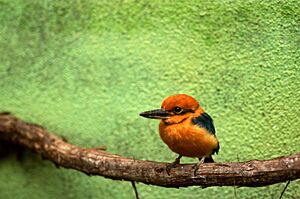
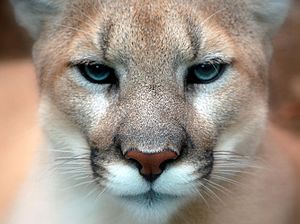
The idea for a zoo in America came after the London Zoo opened to the public in 1847. Dr. William Camac from Philadelphia visited the London Zoo in the 1850s. He then pushed for a zoo to be built in Philadelphia.
On March 21, 1859, the Zoological Society of Philadelphia was officially created. Their goal was to collect animals for public display in Philadelphia. This would help teach and entertain people. Dr. Camac and others raised money and got 33 acres of land by the Schuylkill River. This land used to belong to John Penn, who was the grandson of William Penn.
Opening Day and Early Years
The zoo's opening was delayed by the American Civil War, which lasted from 1861 to 1865. Finally, on July 1, 1874, the Philadelphia Zoological Garden opened its Victorian gates. Over 3,000 visitors came on that first day! It was the only zoo of its kind in the New World at the time.
The zoo started with 200 mammals, including buffalo, deer, wolves, foxes, bears, and monkeys. It also had 67 bird species and 15 reptiles. Reptiles and small mammals lived in The Solitude Mansion, a historic house built in 1785. The zoo's design looked like a beautiful Victorian garden, which you can still see parts of today.
In 1876, the Centennial Exposition was held nearby. U.S. President Ulysses S. Grant even visited the zoo! That year, almost 680,000 people visited the zoo. This was a huge increase and a record that lasted until 1951.
Helping Animals Stay Healthy
In 1901, the zoo started the Penrose Research Laboratory. This was the first lab of its kind in any zoo! It helped reduce animal diseases and made the animals stronger and live longer. The lab would study every animal that got sick and died to learn how to prevent future illnesses. This showed how much the zoo cared about keeping its animals healthy.
Zoo Train Station
From its opening in 1874 until 1902, visitors could arrive at the zoo by train. The Zoological Garden station was right on 34th Street. Since 2013, zoo officials have been working to get this station reopened. This would help more people visit and ease parking problems.
Amazing Animal Births
The Philadelphia Zoo has an amazing history of helping animals have babies. They have had many "firsts" in the zoo world!
- In 1928, the first orangutan and chimpanzee were successfully born in a U.S. zoo.
- In 1956, the first cheetahs were born in a zoo.
- In 1983, the first echidna was born in North America.
- In 2004, the first giant river otter was born in North America.
- In 1985, the first Guam kingfisher was raised by its parents at the zoo.
The zoo also pioneered new ways to care for flamingos. They figured out special feeding techniques to give these birds their bright pink and red colors. They were the first to successfully breed Chilean and greater flamingos in captivity.
Saving Rare Birds
In the 1940s, the brown tree snake arrived on the island of Guam. These snakes caused many native bird species to disappear from the wild. In 1983, the Philadelphia Zoo started the Guam Bird Rescue Project. Their goal was to save the Guam kingfisher and the Guam rail.
The plan was to catch all the remaining kingfishers and rails on Guam. Then, they would start a special breeding program in U.S. zoos. This effort aimed to save these two species from extinction until they could be safely returned to Guam.
Important Events and New Exhibits
On December 24, 1995, a sad fire happened in the World of Primates building. Sadly, 23 animals died from smoke. These included western lowland gorillas, orangutans, white-handed gibbons, and lemurs. All of them were endangered species. After the fire, the zoo installed fire alarms in all animal buildings to prevent this from happening again.
In 1999, the zoo opened a new primate exhibit. It had 2.5 acres of indoor and outdoor areas for 10 different kinds of primates. In 2006, a new big cat exhibit opened. It showed off lions, Siberian tigers, Amur leopards, snow leopards, cougars, and jaguars in spaces that looked like their natural homes.
On May 30, 2009, a new aviary opened. It featured two birds that are extinct in the wild: the Guam rail and the Guam kingfisher. In July 2009, the zoo's last two African bush elephants moved to a sanctuary.
In 2010, a special exhibit called Creatures of Habitat featured over 30 life-size Lego brick statues of endangered animals. These amazing statues were made by artist Sean Kenney.
Zoo360 Animal Trails
In 2011, the Philadelphia Zoo opened Treetop Trail. This was the first part of its amazing Zoo360 animal exploration trail system. Zoo360 is a network of see-through mesh trails. These trails are both high up and on the ground. They let animals explore different parts of the zoo outside of their regular homes! Other trails added later include the Great Ape Trail, Big Cat Crossing, Gorilla Treeway, and Meerkat Maze.
KidZooU and Other Fun
On April 13, 2013, the zoo opened KidZooU. This is also known as the Hamilton Family Children's Zoo. It's one of the biggest projects the zoo has ever done and replaced the old Children's Zoo. KidZooU has many eco-friendly features, like rain gardens and green roofs. It was the first LEED-certified exhibit at the zoo.
In 2018, the zoo introduced a snake mascot named Phang! In 2019, WildWorks opened. This is a 34-foot-high ropes course with bridges and obstacles. There are courses for different ages and skill levels.
During the holiday season (late November to early January), the zoo hosts a walking nighttime light show called Luminature. It has over 1 million lights, holiday music, and illuminated animal actors!
On August 20, 2025, sixteen critically endangered western Santa Cruz tortoises were born at the zoo. This was a very exciting event for conservation!
What You Can See at the Zoo
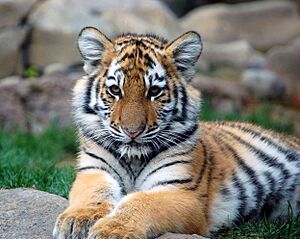
- Zoo360: This is the unique animal trail system. It has five trails: Big Cat Crossing, Gorilla Treeway, Treetop Trail, Great Ape Trail, and Meerkat Maze. Animals can travel along these mesh structures throughout parts of the zoo.
- The Rare Animal Conservation Center: Here you can see some of the world's most endangered animals up close. These include Rodrigues fruit bats, naked mole-rats, and golden lion tamarins.
- Hamilton Family KidZooU & Faris Family Education Center: This children's zoo has indoor and outdoor exhibits with smaller animals. You can even pet and feed some of them! It also has fun educational games.
- African Plains: This area features animals like white rhinoceros, reticulated giraffes, plains zebras, and hippos.
- McNeil Avian Center: This is a large aviary with many bird species, mostly from Africa, Asia, and the Pacific Islands. You can see the Guam kingfisher and Guam rail here, which are extinct in the wild!
- Bird Valley: This area has American flamingos, different kinds of geese, and trumpeter swans.
- Bear Country: You can find four sloth bears and an Andean bear here.
- Big Cat Falls: This is home to many wild cats, including African lions, Amur tigers, Amur leopards, snow leopards, jaguars, and cougars.
- Small Mammal House: This house used to have small mammals like pygmy loris and Hoffmann's two-toed sloth. In 2023, part of it became Spiders Alive!, which has 17 species of spiders and other arachnids. You can still see the zoo's meerkats here.
- Outback Outpost: This area includes emus and a group of red kangaroos.
- PECO Primate Reserve: Opened in 1999, this reserve has Sumatran orangutans, western lowland gorillas, lar gibbons, spider monkeys, and five types of lemurs.
- Penguin Point: Opened in 2018, this habitat is home to 17 Humboldt penguins.
- Primate Passage: Here you can see mantled guerezas and red-tailed monkeys.
- Raptor Ridge: Located in the southern part of the zoo, this area features birds of prey like bald eagles and king vultures. You can also see cheetahs nearby.
- The Reptile and Amphibian House: This house has many species of amphibians and reptiles. You can see giant tortoises, crocodilians, and even the venomous king cobra.
- Water is Life: This exhibit features a family of rare giant otters (the first successfully bred in North America!), red pandas, and common vampire bats.
- Wings of the World: This outdoor aviary has an Asian garden where you can hand-feed Asian birds like Indian peafowls and golden pheasants.
The zoo also offers special behind-the-scenes experiences and overnight stays for groups. They host fun events throughout the year, like Boo at the Zoo for Halloween!
Images for kids
-
A flamboyance of American flamingos
-
A cheetah
-
A red-shanked douc, last held by the zoo in 2018
See also


